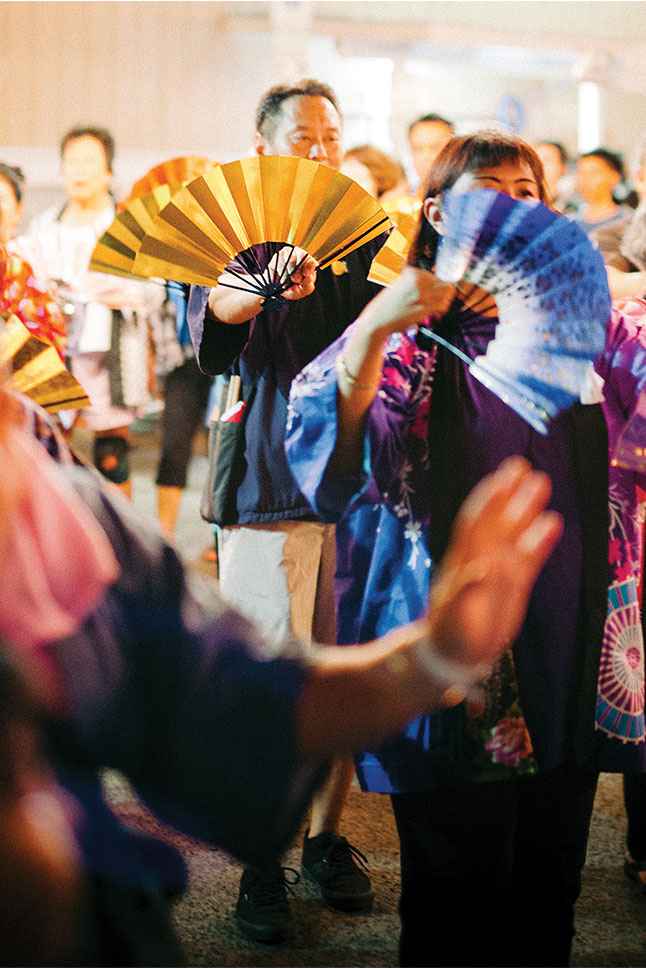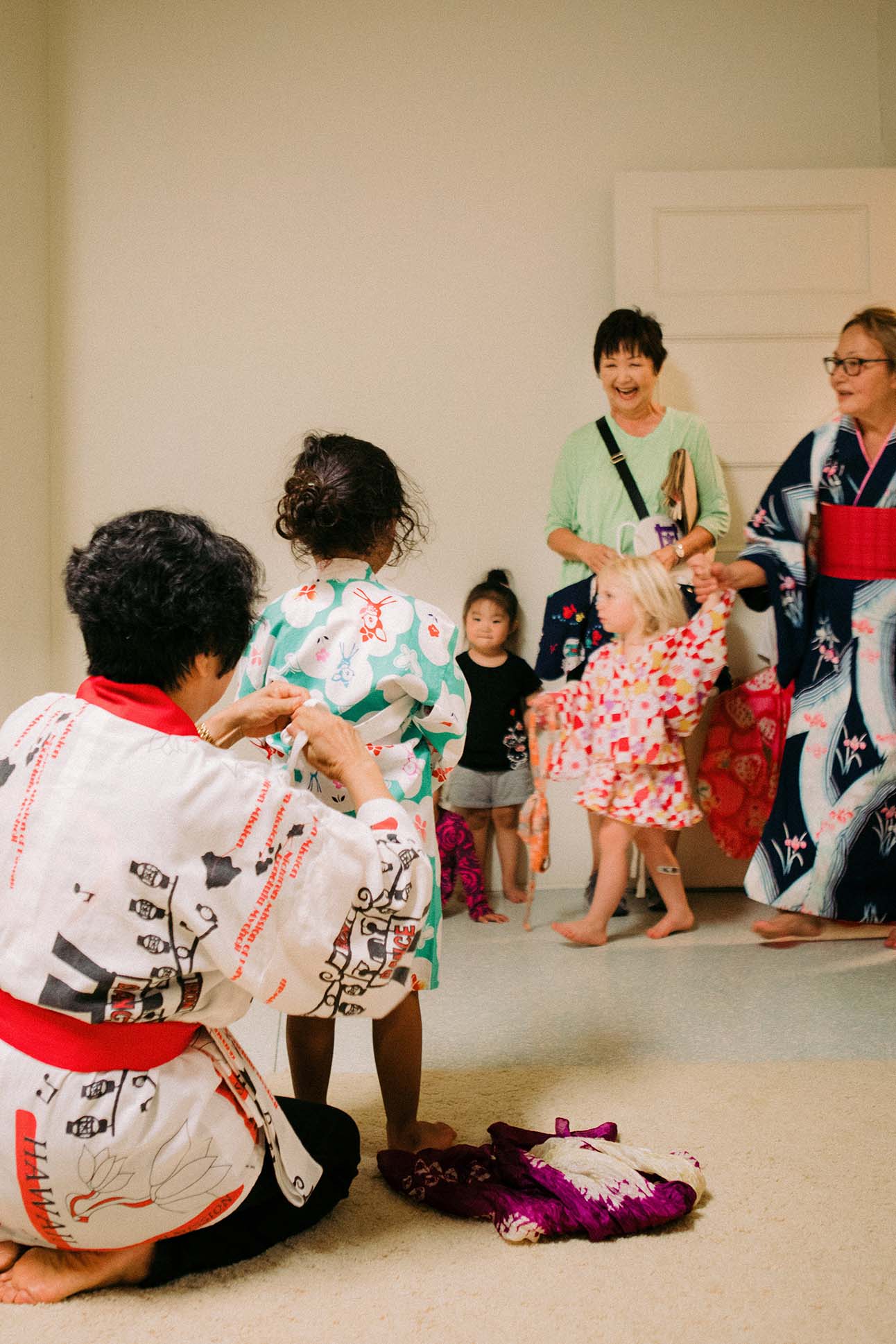In gatherings of community, bon dances celebrate Japanese heritage and pass on ancestral traditions.
Images by Michelle Mishina
Growing up, my best friend Stephanie, like many local Japanese kids in Hawaiʻi, spent afternoons at the local Hongwanji, where she learned Japanese language and culture. She did so at the behest of her issei grandmother, who wished her granddaughter to cultivate ties to the homeland, a place Steph had in fact never been to, but of which her grandmother held in great reverence. Steph bore the burden of such cultural duty with mild reluctance; I tagged along because she was my best friend.
Our sensei were stern, old ladies who shuffled about in yukata, administering lessons on hiragana and the proper way to hold a fan. They clucked their tongues in disapproval when we goofed around. They awarded good behavior with satisfied nods and senbei. But the best days always arrived with summer. At that time, even the strictest sensei loosened up in cheerful anticipation of Bon dance season.
Now, decades later, I still feel the familiar, summertime thrill when seeing paper lanterns strung in temple courtyards and banners hung along fences announcing obon dates. Despite its somber significance of honoring the dead, bon dances remain perennially festive gatherings with an open invite to all.
With the pandemic’s tight grip on the world finally loosened and social restrictions lifted, bon dances in Hawaiʻi have made a triumphant return this summer, welcoming crowds hungry for connection. Woven within the evening’s excitement of dancing, food and fellowship is a subtle, renewed understanding of the importance of community here in the islands. It feels like a homecoming, and it feels good.


In the late 19th century, Hawaiʻi’s agricultural economy was booming. The first influx of Japanese immigrants arrived to work on the sugar plantations. They brought with them cherished cultural traditions, including Obon, the Japanese Buddhist custom of honoring the dead. During Obon, families pay respect to their ancestors by making offerings to family shrines and visiting local temples. It is believed the first Bon dances in Hawaiʻi were held in sugarcane fields and plantation villages.

With its gardens awash in twilight, the grounds of Nichiren Mission of Hawaiʻi resemble a delicate Japanese watercolor.
Narrow stone paths wind around hillocks and lichen-mottled boulders. Series of tōrō stand sentry and illuminate grassy areas.
Girls, clad in kimono, walk with hushed steps to a small pond framed by water lilies and cyperus plants.


Strands of chochin radiate from the yagura, adding a warm glow to the gathering crowd at Nichiren Mission of Hawaiʻi. The bamboo lanterns, reminders to seek the light, also help welcome home ancestral spirits during Obon.

Today Hawai‘i’s Bon dances serve as cheerful reunions of sorts — yearly communions of family and friends and culture. Despite the underlying sense of solemn tradition, the Bon dance atmosphere is fun and festive. Neighbors gather together to talk story. Friendly obachan chuckle as they help adjust each other’s obi. Young children dash off to try their luck with kingyo sukui, the traditional game of scooping goldfish. While many families of Japanese heritage are present to pay homage to their roots, the event is welcoming to all.


As traditional dance songs play over the loudspeaker — sometimes with live drum accompaniment — dancers move in step to the music and gracefully clasp their palms, nod, then bow to the lilting sounds of the shakuhatchi, a bamboo flute, and shamisen, a three-stringed instrument. In Japan, Bon Odori music leans toward traditional song, but in Hawaiʻi, the playlist also includes more pop variations, to the crowd’s delight.

In the mission hall’s foyer, racks of colorful yukata and happi, casual kimonos and straight-sleeved coats, are available to those eager to embrace traditional attire. Typically made of cotton and worn especially during warmer months, a yukata is different from its silk kimono counterpart, but the array of designs and colors in which it is made is equally beautiful. Chrysanthemums, cherry blossoms, and cranes abound, as well as family crests. Hawaiʻi Bon dance dress codes are more casual than ceremonial, more relaxed than reserved. Slippers and shorts are common fare.


In the mission hall’s foyer, racks of colorful yukata and happi, casual kimonos and straight-sleeved coats, are available to those eager to embrace traditional attire. Typically made of cotton and worn especially during warmer months, a yukata is different from its silk kimono counterpart, but the array of designs and colors in which it is made is equally beautiful. Chrysanthemums, cherry blossoms, and cranes abound, as well as family crests. Hawaiʻi Bon dance dress codes are more casual than ceremonial, more relaxed than reserved. Slippers and shorts are common fare.

The smoky aroma of grilled miso cuttlefish sticks rises from a vendor booth. Nearby, andagi sizzle in pans of oil, the fried dough’s sweet popularity evidenced by a long line trailing into the crowd. Though dancing is a big draw for these events held throughout the summer, so are the foods. People indulge in local favorites like musubi, yaki soba, and butter mochi.


A few miles away, in a neighborhood near Waikīkī, a bright summer moon hangs over the Kapahulu Honolulu Fukushima Bon Dance. Chairs surround the yagura, offering their occupants — parents holding sleepy toddlers in their laps, grandparents looking content and nostalgic — ample views of the sea of dancers. It’s a special night for all, and for the ancestors, too, smiling down upon them.

